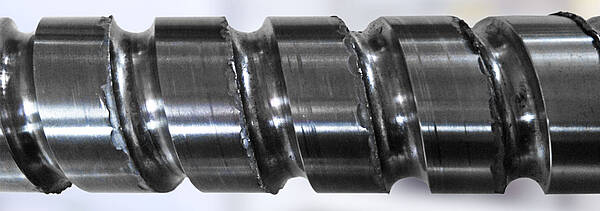Damage Analyses of Ball Screws
Damage analyses by A.MANNESMANN

If damage occurs to one of your ball screws, as the manufacturer we are happy to take care of the inspection in-house if you wish. As part of our diagnostic service, we determine which causes led to the damage and give you appropriately qualified feedback in order to avoid this in the future.
Types of damage analyses:
- Ball screw wear analyses
- Operating and running analyses
- Vibration and noise analyses
- Temperature analyses
Our ball screws are designed for a long service life. A premature failure should be analyzed to be able to take countermeasures that avoid it from repeating.
Damage and Fault Analysis as an Information Tool
The damage and fault analysis is a very important tool for collecting information and gaining valuable findings about the operation of the ball screw as well as the possible reason for the failure. This is to be used to draw conclusions that make further use of the ball screw after repair or replacement possible without the damage occurring again.
In order to obtain an objective analysis result, the ball screw must be considered from the perspective of the application as well as from the production and design perspective.
The damage and fault analysis requires great technical expertise. That is why this analysis can only be carried out by specialists with appropriate expertise who are very experienced in handling ball screws.
Types of damage may include:
- Flaking of shaft, balls and ball raceways
- Wear
- Fretting corrosion on the ball raceway
- Ball impressions from a crash
Systematic Damage Analysis
The procedure for a systematic damage analysis is similar to that for avoiding failures from possible errors (FMEA - Failure Mode and Effect Analysis) where the types of failures are examined with respect to their causes and effects.
- Damage effect (failure effect)
- Type of damage (type of failure)
- Cause of damage (cause of failure)
- Reason for damage (reason for failure)
- Prevention measure
The effect of damage (failure) is always the clear appearance perceived and recognized by the observer. This damage effect is assigned a type of damage (type of failure) through which the effect presumably came about. In this theoretical consideration, several types of damage can also be assigned. The cause of the damage (cause of the failure) or the reason for the damage should now clarify why the type of damage came about with this effect. Suitable measures for avoiding damage (error avoidance) can only be derived from the causal reason.
Damage effects may be:
- Increased running noise
- Increased operating temperature
- Difficulty moving across the entire travel
- Difficulty moving in the area of the bearing
- Increased vibration in the running behavior
- Positioning inaccuracy
Possible frequent causes for a defect are:
- Penetration of foreign bodies
- Contamination
- Missing or incorrect lubrication
- Improper assembly
- Mishandling
- Excessive heat development
When diagnosing, it is important to include all conditions and external influences such as the installation and application, the operating conditions, the course of maintenance and also the environment.
 Germany
Germany

